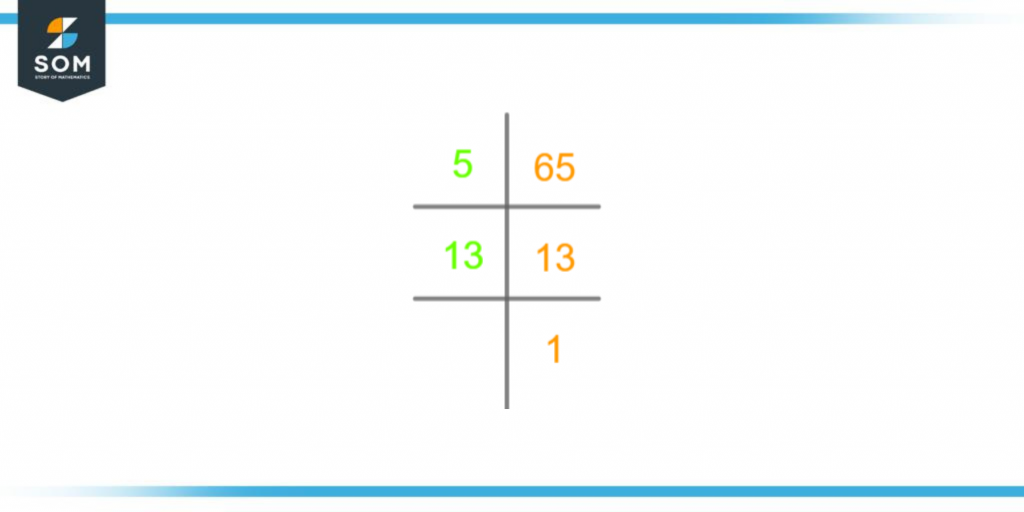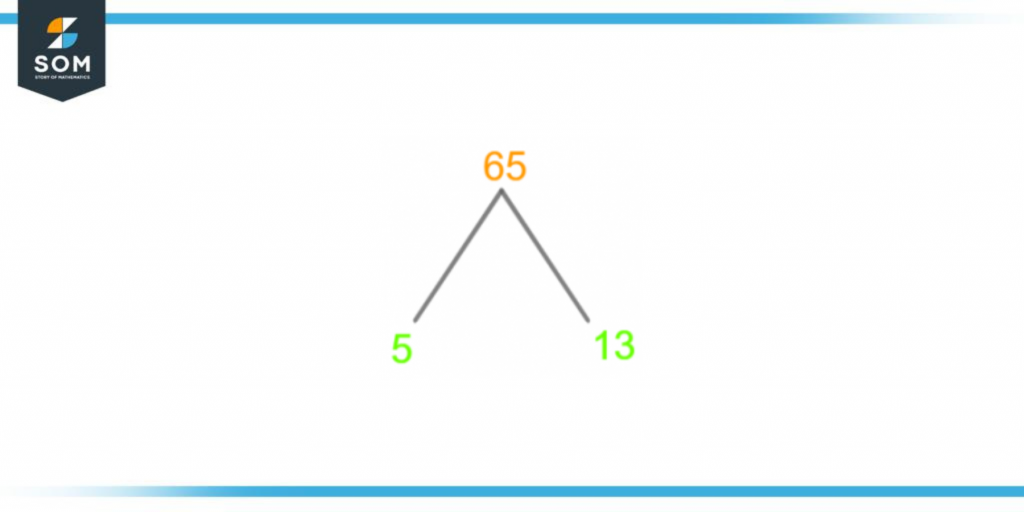JUMP TO TOPIC
Factors of 65: Prime Factorization, Methods, Tree, And Examples
All factors of 65 are the natural numbers that make 65 perfectly divisible, which means that upon dividing 65 by that specific factor, the remainder obtained would always be zero. Such numbers not only produce zero as the remainder of division but also output a product equivalent to 65 when multiplied by each other.

Figure 1 – All possible Factors of 65
In mathematical terms, the natural number 65 is not a prime number which indicates that it will have factors other than 1 and the number 65 itself. In fact, it is an odd composite number which tells us that it has multiple numbers it is perfectly divisible by.
Multiple procedures and techniques have been determined to calculate the factors of any number such as 65. These methods are simplistic yet yield accurate results. One of them is the prime factorization method but for beginners it is encouraged to start with another method called the division method which has been hailed as the easiest method of calculating factors.
In this division method for finding factors, we assume that the numbers which give zero as the remainder is considered a factor. Occasionally upon dividing any number, the quotient can take a decimal form but in the case of factors in the division method, the quotient always remains a whole number. This makes the final quotient a factor for the number as well.
Let’s consider the division of 65 with 5 for clarification:
\[ \frac{65}{5} = 13 \]
As was discussed earlier, if a whole number quotient is produced upon the division of two numbers, the quotient is understood to be a factor as well so in this example stated above both 5 and 13 are the factors of 65.
This article explores the factors of 65 in detail along with examples for a better understanding of the factorization procedures that are used for the calculation of factors of 65.
What Are the Factors of 65?
The factors of 65 are 1, 5, 13, and 65. These are the numbers that generate zero as the remainder whenever 65 is divided from these numbers.
It is understood that the number 65 has a total of 4 factors which makes it a composite number since its factors 5 and 13 are also categorized as composite numbers.
How To Calculate the Factors of 65?
The factors of 65 can be calculated by multiple methods such as the prime factorization method and the division method. Let’s begin with the understanding of one of these methods: the division method which is called the easiest way of determining factors.
The division method is a traditional and simpler approach to determining the factors. According to this method, all the numbers that produce a zero remainder upon division with 65 are considered factors. This is a compulsory condition for factor determination.
Moreover, if the quotient resulting from this division is a whole number then it is also considered a factor. Hence both the quotient and divisor are the factors of the number dividend which in our case is 65. Understanding these conditions in the division method let us proceed to the calculation of the factors of 65:
\[ \frac{65}{ 5} = 13 \]
Both 13 and 5 are factors of 65, as we can see division by 5 gives a whole number 13. So let us look at other factors too:
\[ \frac{65 }{1} = 65 \]
\[ \frac{65 }{13} = 5 \]
\[ \frac{65 }{65} = 1 \]
Through the division method we have calculated the following factors of 65:
Factors of 65 through division method: 1, 5, 13, and 65.
We can see that number 65 has 4 factors where one of them is the number itself and the other is the digit 1 which divides all the natural numbers. These also happen to be the largest and smallest factors respectively.
Factors of 65 by Prime Factorization
Prime Factorization is another method for finding out the factors of any number, what differentiates it from other methods is that we divide it by prime numbers only. This in turn gives factors that are only prime numbers. The division stops when 1 is obtained in the final step.
The previous method for determining factors gave us both composite and prime numbers as the factors for 65. But prime factorization is another method for calculating factors that only gives us the prime factors of any number, in our case, that number is 65.
Prime factors are the numbers that are divisible by 1 and the number itself. It has no other factors.
Through prime factorization, we find out factors that once multiplied, give us the original number which in our case is 65. The product of these prime factors is always the original number. Dividing the number by prime factors also yields a zero remainder.
But the method for finding out these factors is a little different from normal division. In this method, a peculiarity that makes it different from the normal division is that the quotient acts as the dividend for the next step until the division yields the end result 1.
In our case where the number 65 is given, the prime factor for 65 is 5 so we start the prime factorization by this prime number 5, which acts as a divisor for 65 and continues on till we achieve 1 in the last step.
To get a deeper understanding let us look at the math behind prime factorization:
65 $\div$ 5 = 13
13 $\div$ 13 = 1
This factorization is done in multiple steps but a convenient way of writing it down can be:
Prime Factorization of 65 = 13 x 5
The prime factorization of 65 is also shown below:

Figure 2 – Prime Factorization of 65
Factor Tree of 65
A factor tree is a tool deployed to find out the prime factors of any number by breaking it down to prime numbers. It is a visual technique that can represent the prime factors. The factor tree keeps dividing the number till the branch reaches a prime number.
This differentiates it from the prime factorization method which aims to achieve 1 at the end and from the division method which aims to achieve a zero remainder.
At the head of the factor tree sits the number itself which then divides into branches of whole numbers that further divide by acting as a dividend until a prime factor is reached at its tips of the roots.
This division into branches of different numbers stops when at the tips of the branch any prime factor is obtained. This can be seen in figure 2 below:

Figure 3 – Factor Tree of 65
Factors of 65 in Pairs
The factors of any number can be divided into pairs, if these pairs yield back the original number they are called the factor pair of the given number. In our case when the number given is 65, the factor pair for 65 consists of a pair of numbers that give us 65 when multiplied by each other. These factor pairs can either be positive or negative depending on the sign.
Since the number 65 has 4 factors in total so their factor pairs are given below:
1 x 65 = 65
5 x 13 = 65
So there are 2 positive factor pairs of the number 65. These positive factor pairs are:
Positive factor pairs of 65 = (1, 65), (5, 13)
As with the positive factor pairs, the integer component stays the same but for negative factor pairs we just add a negative (-) sign:
-1 x -65 = 65
-5 x -13 = 65
The above equation has two negative signs on the left hand side of the equation, when multiplied, they give a positive sign on the right hand side. The negative pairs of factors of 65 are given below:
Negative Factor pairs of 65 = (-1, -65), (-5, -13)
Factors of 65 Solved Examples
To further improve the understanding of the concept of factors of 65, let’s take a look at some simple examples concerning the factors of 65.
Example 1
Calculate the total number of factors of 65 through the factorization method.
Solution
The factorization method is a technique used to calculate the factors of any number. In order to calculate the factors of any given number all you need to do is note down its factorization. The factorization of 65 is given as:
Factorization of 65 = 13 x 5 x 1
To calculate the total number of factors, keep in mind that 1 and the number itself are always the factors of any given number, let it be a prime or a composite. In this case, we include the number 1 and 65 in the total number of factors as well.
Hence, the number 65 has a total of 4 factors: 1, 5, 13, and 65
Example 2
Calculate the average of all the factors of 65.
Solution
Before calculating the average of all the factors of 65, let’s first list down the factors of 65.
The factors of 65 are:
Factors of 65 = 1, 5, 13, 65
For determining the average, use the formula given below:
\[ Average = \frac{\text{Sum of all the factors}}{\text{Total number of factors}} \]
\[ Average = \frac{1+5+13+65}{4} \]
\[ Average = \frac{84}{4} \]
Average = 21
Hence, the average of all the factors of 65 is 21.
All images/mathematical drawings are created with GeoGebra.
